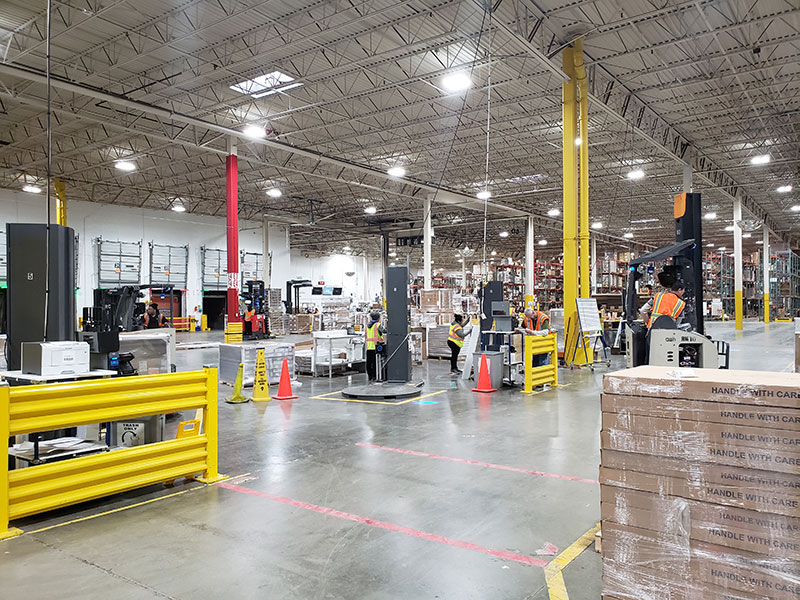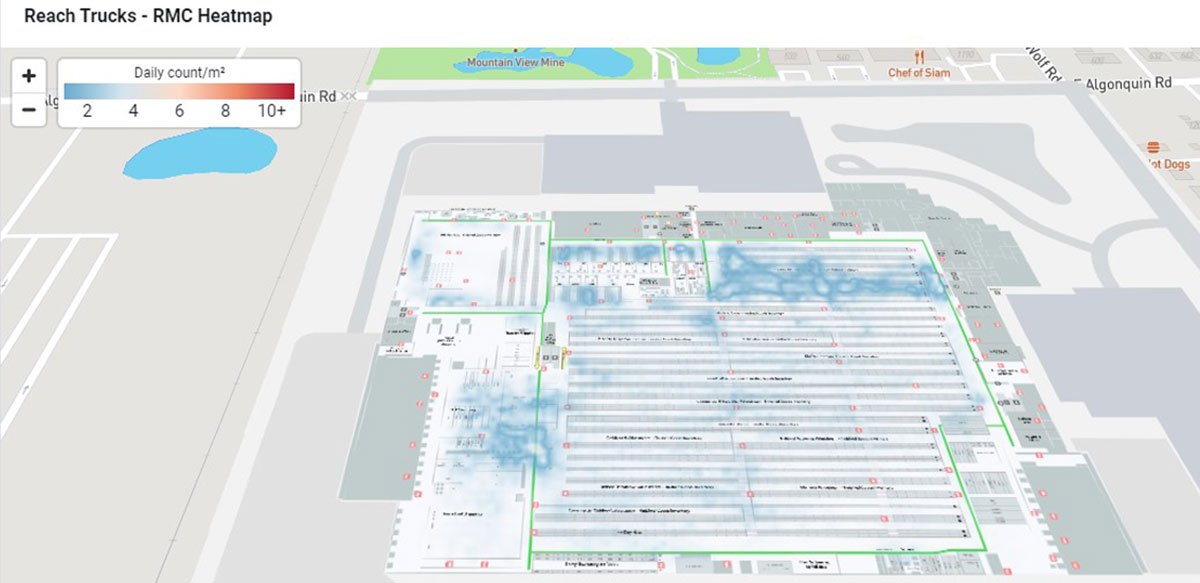Connected lighting can allow us to market ‘light’ as an asset rather than a commodityBy Steve Lydecker
Photo by:
In 2021, the IES published ANSI/IES LP-12-21, IoT Connected Lighting. This important document provides guidance to lighting practitioners for evaluating connected lighting and Internet of Things (IoT) systems and applications.
Using a lighting system to generate valuable data to produce tangible business benefits is a paradigm shift in our industry. As such, it can be difficult for practitioners and owners alike to translate theoretical to real-world application benefits. Consider color: It is one thing to explain it to a client, another to see differences in light source color characteristics in the field. Seeing is believing, yes, but really it is about understanding.
This notion resulted in a presentation I delivered at the 2022 IES Research Symposium. At Acuity, we have gained considerable experience delivering IoT connected lighting solutions, including use at our own facilities. But before diving into real world applications, some background is in order so as to set a foundation for evaluating applications.
First, let’s look at how the value of lighting is understood. Light is universally viewed as a commodity, an ongoing operating cost that can be minimized by investing in energy efficiency. More enlightened clients, however, understand lighting—the application of light—is an asset, a tool that can be used to promote occupant comfort, wayfinding, retail sales, safety and more through value-added design and products.
Calculating return on investment for energy-efficient lighting is far simpler than doing so for value-added design. Being able to articulate that value means the difference between satisfying a client need and being able to walk into almost any organization and identifying a need.
A good starting point is the 3-30-300 real estate rule of thumb, which postulates an average annual cost of sq ft of $3 for energy, $30 for real estate, and $300 for salaries and benefits. A simple argument is cutting energy costs in half can deliver $1.50 per sq ft savings, but even a 1% productivity benefit can deliver a value of $3 per sq ft. Now consider a 2013 World Green Building Council report, which assigned a 23% improvement in productivity (work-product, absenteeism, occupant well-being) due to “better lighting” in LEED-certified buildings. The value of high-quality lighting far exceeds the energy savings.
IoT connected lighting takes this idea and empowers it by 1) providing data the owner can use to measure and tune operations on an ongoing basis, and 2) enabling new services from an asset that becomes manageable. While its potential for value is far reaching, it should be considered for every large building, particularly if it is owner-occupied or where the client is engaged in a long lease. These projects are likely your best opportunity to sell more design services related to the Internet of Things.



Since it manifests in multiple ways in application, a useful definition of the Internet of Things focuses on core capabilities. Simply put, an IoT solution consists of a network of sensors and computing devices that can be globally programmed for sophisticated sequences of operations, interoperate and communicate, and produce data and analytics.
The lighting system is a leading candidate for IoT solution delivery. Luminaires are common (visually accepted and widely distributed, typically at the ceiling plane) building hardware that is connected to power. Lighting is served by control points that can be easily networked at the building or even campus level, using either a dedicated lighting network, building network or the internet. Software makes the network programmable and enables analysis of data fed to a central server or the cloud.
Comparing an IoT connected lighting system to one that is compliant with a majority of commercial building energy codes, a designer will likely spot far more familiar than unfamiliar elements. In LP-12, the IES concisely captures the major differences as being “more team members, diversified project goals beyond traditional lighting project criteria, and additional coordinated components. The decision-making may include collaborative development of financial analysis.”
This necessitates familiarizing oneself with the technology and major products available, a high degree of discipline relating to coordination and articulating the design intent, and working with trusted manufacturing partners who can provide the necessary support and product quality. It requires the design team to know what data is important, how it securely travels point to point, and what equipment is needed for this.
It also begs an owner that knows what it wants from an IoT-enabled lighting solution, but this may not be forthcoming. In this case, the owner may wish to invest in a solution that is “IoT ready”—that is, fully capable and ready to be configured and used at a later date. A useful metric here is to evaluate the cost of a satisfactory lighting control system versus a satisfactory system that also has IoT connected capability. Another piece of this is that it can be expensive to upgrade an installed control system; in many cases, complete replacement might be necessary. If the IoT-enabled premium is, say, 3%, then the owner must decide whether to pay that premium now or possibly pay 103% of the cost of the original system later plus the cost of installation and associated disruption.
In LP-12, use cases ranging from space utilization to visible light communication to tailored personal environmental control are identified as applying to eight project types ranging from office buildings to smart cities. In fact, there are even more opportunities, such as eliminating the costs and mundane activities associated with mandatory monitoring of emergency lighting.
As we are still in early days for this technology, the “low-hanging fruit” is likely to serve as standard blocks on which more complex applications will be developed, growing potential value even further. Here are five of those uses:
Lighting management, measuring and monitoring: This functionality is simple bedrock for an IoT connected lighting system. Clients can fine-tune sequences of operations, measure energy consumption and energy savings, and monitor devices for proactive maintenance. In a large application such as a large building or street lighting, the latter capability can not only ensure all lighting is operational but achieve significant efficiencies in addressing any failures. These features alone can accrue significant added value.
Emergency lighting: A centralized networked lighting control system enables flexible, powerful and cost-effective emergency lighting control. In this solution, a central device senses power loss and activates emergency lighting for pre-selected luminaires in parts of or even the entire building, fed by a centralized emergency power source. Using software, designers can select emergency luminaires and define at what level they will emit light. This type of solution can produce cost efficiencies in emergency power sizing, reducing hardware such as dedicated relays, and in inspection through proper control labeling and monitoring with automatic diagnostics.
Space utilization: A low-hanging fruit in IoT connected lighting, this strategy involves gaining a view of what spaces in the building are occupied and unoccupied through the day, week and year. While camera-based systems are available for this real estate purpose, they may introduce privacy concerns. Occupancy sensors connected to the lighting system can capture the information as part of their standard operation. Using the data, facility managers can optimize use of overall space and individual spaces such as conference rooms, thereby gaining more value from built real estate.
Asset tracking: This strategy involves adding a technology layer consisting of radios that actively beacon and receive signals from battery-powered tags affixed to any mobile asset in the space. In the software, activity can be mapped on a per-asset basis or shown over time.
In one such project at Acuity Brands in Des Plaines, IL, (see Figure 1), Bluetooth radios detect the location of warehouse forklifts to send this information to gateways that in turn process the data and feed it to the Cloud for retrieval and analysis. This strategy was incorporated into an LED upgrade, which generated a three-and-a-half-year payback. The forklift tracking, however, resulted in operational efficiencies in the form of
eliminating a significant number of vehicles, resulting in a four-month payback on this measure.
Indoor positioning: Using Bluetooth beacons embedded in general luminaires combined with visible light communication, larger retailers can communicate directly with customers in their stores. At nearly all 1,800-plus stores operated in the U.S. by megaretailer Target, for example, more than 2 million LED luminaires were installed with embedded beacons that work with a Target app on customer cellphones to allow wayfinding, product finding and location-based couponing.
Lighting practitioners can support clients by making them aware of IoT opportunities and helping them visualize these opportunities in their applications. Because each application is different, it can be helpful for practitioners to understand what the technology can do and then ask the owner questions until they understand what the technology can do for them. Part of this is to begin allying with manufacturers that thoroughly understand and support it.
In doing so, the lighting practitioner will provide value while in the process create it for themselves—by enabling the sale of more design services, accessing a long-term market with potential strong growth and high profitability, and possibly creating a framework of value justifying other quality lighting recommendations.


